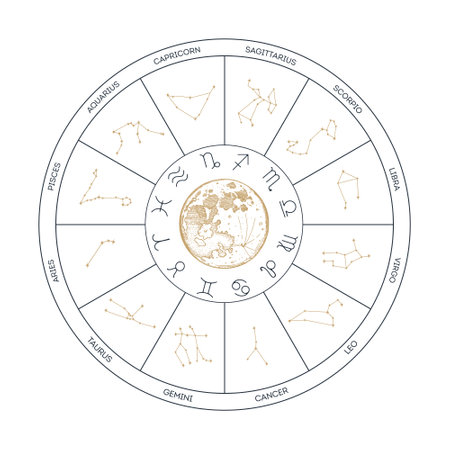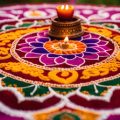1. Understanding Rahu-Ketu Energies in Indian Built Spaces
In the rich tapestry of Indian culture, the celestial nodes Rahu and Ketu hold a unique place, deeply influencing architectural practices and the spatial dynamics of communities. These astrological entities, rooted in ancient Vedic traditions, are considered potent forces that govern not only individual destinies but also the collective energy of homes, mohallas (neighbourhoods), and local areas. In Indian astrology, Rahu symbolizes illusion, obsession, and material desires, while Ketu represents spiritual liberation, detachment, and introspection. Their interplay is believed to create sensitive spots within built environments, shaping both the physical layout and emotional atmosphere of spaces where people live and interact. For many Indian families and community planners, understanding these energies is essential when designing or selecting homes and neighbourhoods. The placement of entrances, courtyards, kitchens, and even religious altars may be guided by traditional wisdom on Rahu-Ketu influences to ensure harmony and prosperity. In mohallas across cities like Delhi, Lucknow, or Chennai, elders often discuss the vibe of a lane or chowk in terms of these cosmic factors—sometimes attributing frequent disputes or unrest to the unseen play of Rahu-Ketu energies. This deep-rooted belief system not only shapes personal choices but also manifests in communal rituals such as vastu pujas or local festivals intended to balance these forces within the urban fabric. As a result, understanding Rahu-Ketu’s cultural and astrological relevance remains integral to interpreting how Indians perceive their built environment—not just as physical structures but as living spaces resonating with cosmic energy.
2. Contextual Analysis: Mohalla as a Spatial Concept
The concept of the Mohalla is deeply woven into the urban fabric of Indian cities, carrying both historical resonance and spatial ingenuity. Traditionally, a Mohalla refers to a neighbourhood or local area, acting as a vital node in the larger urban network. Its origins can be traced back to medieval India, where social cohesion, communal interaction, and localized governance were crucial for everyday life.
From a spatial perspective, Mohallas are distinguished by their organic layout—narrow lanes (galiyan), interconnected courtyards (aangan), and compact housing clusters—that foster close-knit community relationships. Unlike Western grid-based city planning, Indian Mohallas emphasize shared spaces and collective amenities, such as wells (kuan), temples or mosques, and local markets (bazaars). This design not only enhances security but also ensures that daily activities—like fetching water, religious gatherings, or evening chai pe charcha—occur within arm’s reach.
The Socio-Spatial Dynamics of the Mohalla
The Mohalla structure acts as more than just a residential zone; it is an ecosystem where cultural identities flourish. Caste, religion, occupation, and language often define the character of each Mohalla. Here is a comparative table illustrating key aspects:
Aspect |
Mohalla Features |
Impact on Daily Life |
|---|---|---|
Spatial Layout |
Narrow lanes, central gathering spots, clustered homes | Promotes social interaction, safety, and walkability |
Community Structure |
Caste/religion/occupation based clusters | Facilitates trust, support systems, and shared traditions |
Amenities & Infrastructure |
Shared wells, places of worship, bazaars within walking distance | Smoothens daily routines and strengthens communal bonds |
Cultural Events |
Festivals celebrated collectively in open spaces or courtyards | Reinforces identity and intergenerational connections |
This community-centric planning has influenced how residents perceive space—not as private territory but as an extension of family and kinship networks. The resulting sense of belonging makes the Mohalla resilient against urban stressors and external disruptions.
![]()
3. Identifying Rahu-Ketu Sensitive Spots within Local Areas
Integrating Vedic Insights with Urban Mapping
The process of identifying Rahu-Ketu sensitive spots in Indian mohallas and localities draws deeply from both Vedic astrological traditions and the urban spatial logic unique to each region. Traditionally, elders, pandits, and vastu experts have observed certain patterns—such as unusual disruptions, consistent conflicts, or recurring misfortunes—that are believed to be manifestations of the malefic effects of Rahu and Ketu. These insights are often passed down orally, forming a layer of community wisdom that directly influences how urban spaces are perceived and used.
Community Knowledge and Spatial Narratives
Local residents contribute significantly to the mapping of these sensitive areas by recounting stories, events, and shared experiences tied to specific chowks, galiyan, or even intersections where inexplicable incidents occur. For example, a nukkad (street corner) with frequent disputes or an old haveli consistently avoided at night may be marked as ‘Rahu-Ketu prabhavit sthal’ (impacted spot). This collective memory forms an informal but powerful database for further exploration.
Overlaying Traditional Wisdom with Urban Layouts
Urban planners and vastu consultants increasingly overlay these traditional markers onto contemporary maps. They consider street orientation (vaastu alignment), proximity to religious sites like mandirs or dargahs, water bodies such as kunds or talab, and key transit points like chaurahas. By integrating GIS technology with oral narratives, specialists can visualize clusters of potentially sensitive zones. This mapping not only respects the cultural pulse of each mohalla but also helps in designing interventions—like installing yantras or organizing community pujas—to neutralize negative energies.
Ultimately, the identification process is a collaborative effort that bridges ancient wisdom and modern spatial thinking, ensuring that the unique character and wellbeing of every Indian locality is preserved while remaining sensitive to cosmic influences.
4. Socio-Cultural Implications of Sensitive Spots
Community Perceptions and Interactions
The presence of Rahu-Ketu sensitive spots within mohallas and local areas plays a significant role in shaping social dynamics across India. In many regions, especially in North India and parts of Maharashtra, communities attribute certain events or patterns—such as frequent disputes, health issues, or business failures—to the influence of these astrological zones. This perception often leads to collective behaviors, including avoidance of specific streets during particular lunar phases or organizing community rituals to neutralize perceived negative effects. The integration of such beliefs reinforces neighbourhood solidarity but may also result in the exclusion of outsiders or marginalized groups from participating in key local traditions.
Impact on Property Values
The real estate market in cities like Delhi, Varanasi, and Chennai exhibits clear trends influenced by the local understanding of Rahu-Ketu sensitive locations. Properties believed to be located at these sensitive points often see fluctuations in value, either due to superstitious avoidance or increased demand if counter-remedies (like vastu corrections) have been implemented. The table below summarises regional differences:
| Region | Effect on Property Value | Common Community Response |
|---|---|---|
| North India (Delhi, UP) | Lowered value without remedies; stable after rituals | Collective pujas; avoidance of construction during inauspicious times |
| South India (Chennai, Bangalore) | Slight impact; emphasis on vastu compliance | Consultation with astrologers before purchase |
| Maharashtra (Mumbai, Pune) | Variable; depends on urban myths and builder reputation | Preference for newly constructed properties with vastu clearance |
Influence on Local Customs and Festivals
The perceived presence of Rahu-Ketu sensitive spots directly impacts the scheduling and scale of local festivals and religious processions. For instance, some mohallas postpone important rituals like Satyanarayan Katha or Ganesh Visarjan if they coincide with astrological periods associated with heightened sensitivity. In Gujarat and Rajasthan, elders may discourage marriages or housewarming ceremonies during such periods, citing traditional panchang calculations.
Cultural Adaptation Across Regions
While the core belief in Rahu-Ketu influences remains consistent, adaptation varies. Urban areas blend modern urban planning with traditional consultations, whereas rural communities rely heavily on oral traditions and advice from temple priests or local pandits. This interplay between architecture, spatial layout, and astrological beliefs highlights how deeply embedded these concepts are within India’s socio-cultural fabric.
5. Design Strategies and Vastu Integration
Architectural Responses to Rahu-Ketu Sensitive Spots
Designing spaces within Indian mohallas and local areas that are influenced by Rahu-Ketu sensitive spots requires a nuanced understanding of both astrological energies and traditional spatial wisdom. Architects and planners in India can incorporate indigenous principles to mitigate the subtle effects of these celestial nodes, ensuring harmonious living environments for residents.
Adopting Vastu Shastra in Urban Layouts
Vastu Shastra, India’s ancient science of architecture, offers guidelines that align spatial orientation with cosmic energies. For zones identified as Rahu-Ketu sensitive, aligning main entrances away from the northwest (Rahu) and southwest (Ketu) directions can help reduce negative influences. Central courtyards, open spaces, and well-ventilated rooms foster positive energy flow, counterbalancing any disruptive astrological effects.
Spatial Zoning and Placement Recommendations
Residential layouts should allocate private spaces such as bedrooms and meditation rooms in calm, less-exposed parts of the house, ideally avoiding direct alignment with sensitive Rahu-Ketu axes. Community gathering spaces—like chaupals or panchayat halls—can be positioned in the northeast or east sectors for enhanced social harmony.
Material Choices and Cultural Symbolism
Building materials play an important role in balancing energies. In areas marked by Rahu-Ketu influence, locally sourced natural materials like terracotta, stone, or wood are recommended for their grounding properties. Incorporating auspicious symbols—such as rangoli patterns at entryways or Tulsi plants in courtyards—adds layers of cultural protection and positivity.
Sensitive Landscaping and Environmental Cues
Landscaping around homes and mohallas can further buffer sensitive spots. Planting sacred trees like peepal or neem along peripheries, using water features on the north or northeast side, and ensuring unobstructed sunlight into main living areas all resonate with Vastu and Indian traditions to deflect malefic influences.
Towards Holistic Community Wellbeing
The integration of architectural design strategies with Vastu Shastra creates a holistic approach for mitigating Rahu-Ketu sensitivities in Indian neighborhoods. By blending traditional wisdom with modern spatial planning, designers can support physical comfort, psychological wellbeing, and spiritual harmony throughout diverse localities across India.
6. Case Studies: Examples from Indian Cities
Delhi: Harmonising Heritage and Cosmic Energies
In the heart of India’s capital, Delhi’s mohallas exemplify a unique interplay between ancient astrological beliefs and modern urban living. In Old Delhi, especially around Chandni Chowk, certain lanes and chowks are regarded by local residents as Rahu-Ketu sensitive spots. These beliefs influence not only the orientation of homes but also the placement of community shrines and spaces for religious rituals. Local narratives suggest that shops and houses in these zones are periodically cleansed through traditional ceremonies, aiming to neutralise perceived negative energies. Urban planners in Delhi have begun acknowledging these cultural overlays during redevelopment projects, incorporating feedback from community elders and vaastu consultants to ensure harmony between heritage structures and contemporary needs.
Ahmedabad: Integrating Astrological Traditions in Pols
Ahmedabad’s historical pols (gated neighbourhoods) provide another compelling example. Here, the identification of Rahu-Ketu sensitive areas often emerges from oral histories passed down generations. In some pols, entrances are deliberately shifted or modified based on advice from local astrologers to avoid direct alignment with spots considered inauspicious. This practice is particularly evident during major renovations or new constructions within the old city. The communal approach ensures that any architectural adjustments reflect both collective safety and respect for traditional wisdom. Such sensitivity towards spatial arrangement demonstrates how astrological perceptions continue to shape Ahmedabad’s evolving urban landscape.
Kolkata: Cultural Syncretism in Urban Quarters
Kolkata’s para culture—its dense network of neighbourhoods—offers a vibrant tableau where Rahu-Ketu beliefs blend seamlessly with other local customs. In North Kolkata, families often consult pandits before moving into new apartments, especially if the area has a reputation for being cosmically sensitive. Local clubs and puja committees sometimes organise collective rituals at sites flagged as “hotspots” for astrological turbulence. Notably, in some neighbourhoods near Kalighat, stories abound of how specific alleys gained notoriety due to recurring incidents believed linked to Rahu-Ketu influences. These tales are woven into the fabric of everyday life, guiding everything from housewarming ceremonies to the spatial layout of courtyards and communal gathering spots.
Local Adaptation and Community Agency
Across these cities, what emerges is a dynamic process where local knowledge systems interact with formal urban planning. Whether through adjusting street alignments, conducting purification rituals, or reconfiguring built spaces, communities assert agency over their environments while reaffirming cultural identity. These case studies highlight the importance of respecting indigenous perspectives when analysing or intervening in India’s complex urban mosaics.


